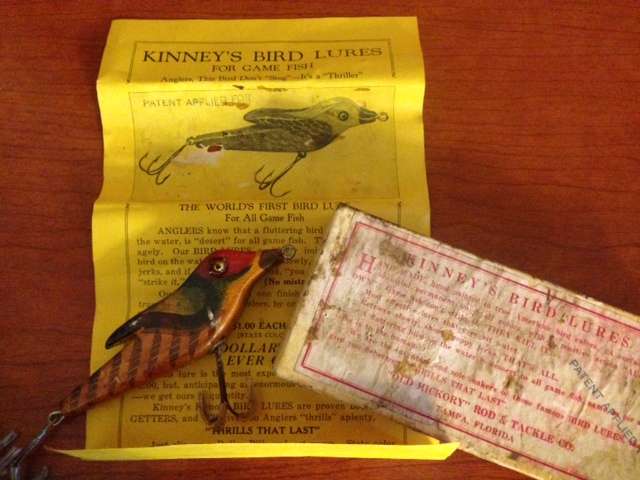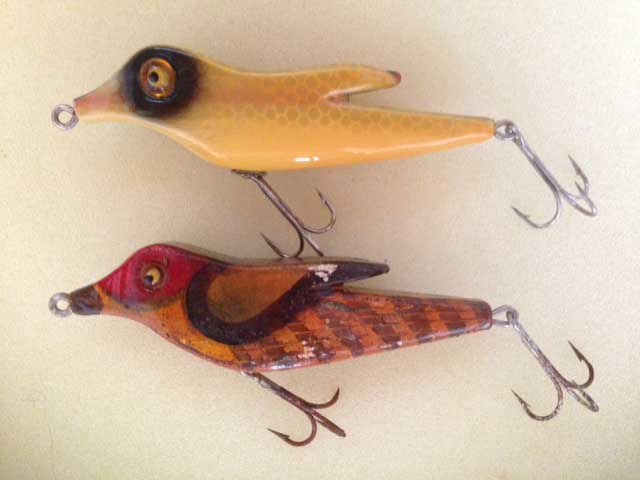
In 1919, a man named Herbert A. Kinney introduced one of the most unusual fishing lures of all time, and one that challenged conventional wisdom of the period. Kinney proclaimed his to be “the most effective lure to ever hit water!”
What was his invention?
It was a crudely-shaped bird lure, designed to mimic a live, drowning bird.
Kinney believed song birds, like the sparrow and redwing blackbird, were the ultimate prey of bass — particularly large bass — and he set out to prove that theory to anglers across the country.
Kinney carved his bird lures from wood, then hand-painted them in what he deemed “true American bird colors.” Although they possessed a certain charm, his paint schemes were actually quite abstract and barely resembled the real birds he was trying to portray.
Once the paint process was complete, he added glass eyes, a line tie and a pair of large treble hooks. The birds were then boxed with paperwork explaining their advantages, along with instructions on how to fish them effectively.
Kinney’s bird lure must have come as a shock to the angling world. Until that time, bass lures were inspired by various insects, baitfish, frogs and mice. To suggest that a bass might prey on birds was preposterous to many, and some surely scoffed at the notion.
Nevertheless, Kinney would not be denied, claiming that his invention would fool large bass better than any other surface lure … so long as the angler imparted the correct movements with the rod. He claimed his bird lure had “an action all its own!” and that “a fluttering bird on the water is dessert to all gamefish, the same as pie and cake is to the human.”
The Proof is in the Plumage
Over the years I’ve observed bass striking at birds — usually redwing blackbirds. And on one particular occasion I noticed a bird hovering just above the water near a stand of reeds. Suddenly, with a violent splash, the bird was gone. It happened so quickly, I wasn’t sure what I saw.

Some years later, however, I was presented with undeniable proof.
It happened during a buddy tournament on the Tsala Apopka Chain of Lakes in north-central Florida. I had just caught a bass weighing more than 7 pounds and, after placing it in the livewell, the fish regurgitated a wad of feathers and flesh. As disgusting as it sounds, there were enough remains to positively identify it as a gallinule — a small chicken-like bird that wades through aquatic vegetation.
At that point I knew, without a doubt, bass eat birds! And I suspect Kinney must have witnessed something similar. Otherwise, how would he have come up with his bird-lure concept?
Not-So-Humble Beginnings
Not only was Kinney in the lure business, his Old Hickory Tackle Company made hand-crafted rods — each fashioned from select dowels of hickory. He also developed one of the first weedless hooks for bass fishing, called “Kinney’s Guaranteed Weedless Hook.”
As his bird lures gained popularity, Kinney sought help from manufacturing giant, James Heddon & Sons. Their job was to paint, assemble and distribute his birds. At that point they were no longer painted by hand. Instead, Heddon’s highly-skilled craftsmen sanded and airbrushed them to a more refined finish. The color schemes changed too, some even matching Heddon’s own catalog patterns.
Unfortunately, soon after forming an alliance with Heddon, Kinney’s bird lures disappeared from the market. Apparently America’s anglers were no longer keen on the concept of bass preying on birds, and the baits faded into obscurity.
For today’s vintage tackle collector, a Kinney Bird is considered a true prize. To find one in its original box with paperwork would be beyond rare. But as short-lived and obscure as they may have been, Kinney Birds are prime examples of true American folk-art as it relates to fishing, and they will always hold a prominent place in our angling heritage.

